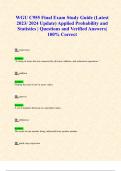Exam (elaborations)
Test Bank - Leifers Introduction to Maternity and Pediatric Nursing in Canada, 1st Edition (Keenan-Lindsay, 2024), Chapter 1-33 | All Chapters
Test Bank - Leifers Introduction to Maternity and Pediatric Nursing in Canada, 1st Edition (Keenan-Lindsay, 2024), Chapter 1-33 | All Chapters
[Show more]












